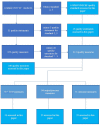Baseline assessment of the WHO/UNICEF/UNFPA maternal and newborn quality-of-care standards around childbirth: Results from an intermediate hospital, northeast Namibia
- PMID: 36699289
- PMCID: PMC9869061
- DOI: 10.3389/fped.2022.972815
Baseline assessment of the WHO/UNICEF/UNFPA maternal and newborn quality-of-care standards around childbirth: Results from an intermediate hospital, northeast Namibia
Abstract
Background: Quality of care around childbirth can reduce above half of the stillbirths and newborn deaths. Northeast Namibia's neonatal mortality is higher than the national level. Yet, no review exists on the quality of care provided around childbirth. This paper reports on baseline assessment for implementing WHO/UNICEF/UNFPA quality measures around childbirth.
Methods: A mixed-methods research design was used to assess quality of care around childbirth. To obtain good saturation and adequate women opinions, we purposively sampled the only high-volume hospital in northeast Namibia; observed 53 women at admission, of which 19 progressed to deliver on the same day/hours of data collection; and interviewed 20 staff and 100 women who were discharged after delivery. The sampled hospital accounted for half of all deliveries in that region and had a high (27/1,000) neonatal mortality rate above the national (20/1,000) level. We systematically sampled every 22nd delivery until the 259 mother-baby pair was reached. Data were collected using the Every Mother Every Newborn assessment tool, entered, and analyzed using SPSS V.27. Descriptive statistics was used, and results were summarized into tables and graphs.
Results: We reviewed 259 mother-baby pair records. Blood pressure, pulse, and temperature measurements were done in 98% of observed women and 90% of interviewed women at discharge. Above 80% of human and essential physical resources were adequately available. Gaps were identified within the WHO/UNICEF/UNFPA quality standard 1, a quality statement on routine postpartum and postnatal newborn care (1.1c), and also within standards 4, 5, and 6 on provider-client interactions (4.1), information sharing (5.3), and companionship (6.1). Only 45% of staff received in-service training/refresher on postnatal care and breastfeeding. Most mothers were not informed about breastfeeding (52%), postpartum care and hygiene (59%), and family planning (72%). On average, 49% of newborn postnatal care interventions (1.1c) were practiced. Few mothers (0-12%) could mention any newborn danger signs.
Conclusion: This is the first study in Namibia to assess WHO/UNICEF/UNFPA quality-of-care measures around childbirth. Measurement of provider-client interactions and information sharing revealed significant deficiencies in this aspect of care that negatively affected the client's experience of care. To achieve reductions in neonatal death, improved training in communication skills to educate clients is likely to have a major positive and relatively low-cost impact.
Keywords: Namibia; WHO/UNICEF/UNFPA; childbirth; maternal and newborn; quality-of-care.
© 2023 Siseho, Mathole and Jackson.
Conflict of interest statement
The authors declare that the research was conducted in the absence of any commercial or financial relationships that could be construed as a potential conflict of interest.
Figures
References
-
- United Nations Inter-Agency Group for Child Mortality Estimation (UN IGME). Levels & Trends in Child Mortality Report 2021. New York: United Nations Children’s Fund (UNICEF) (2021). Contract No.: ISBN:978-92-806-5321-2.
-
- WHO/UNICEF/UNFPA. Standards for improving quality of maternal and newborn care in health facilities. Geneva, Switzerland: World Health Organization. (2016). 84 p.
LinkOut - more resources
Full Text Sources




